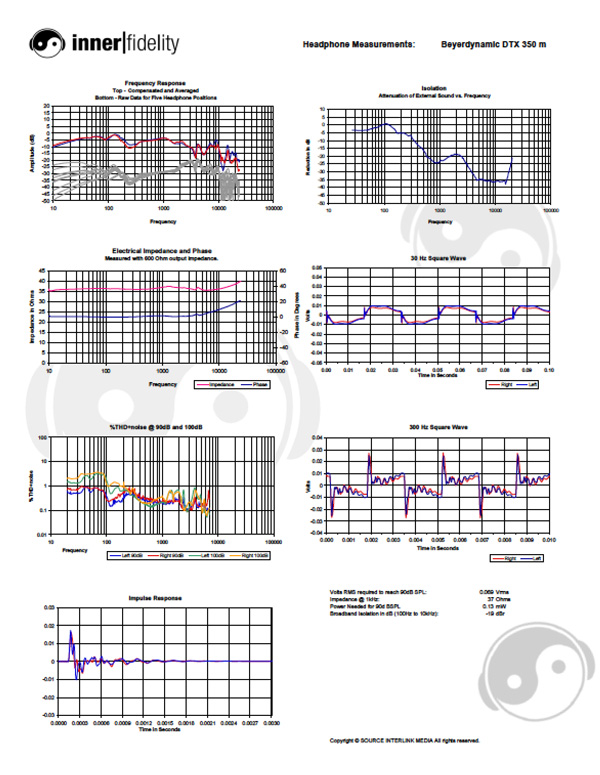| Columns Retired Columns & Blogs |
The Inexpensive and Great Sounding Beyerdynamic DTX 350 m Measurements
Measurements


Click on graphs image to download .pdf for closer inspection.
Raw frequency response plots show clear difficulty getting a good seal to retain bass response. The ears of my dummy head are harder than real ears, and getting a seal on on-ear headphones can be quite challenging. On my ears they seemed to seal much more reliably. Still, be aware that getting a good seal can mean the difference between solid bass response and something less with reduced tightness of bass. Above around 200Hz, frequency response seems quite stable with headphone movement.
Run-up to 3.5kHz from 300Hz has good shape and delivers a solid portrayal and balance with vocals. After 3.5kHz response remains a tad elevated through 10kHz. Between the bass elevation and this slightly elevated treble response, these cans are slightly "V" shaped...but in a tasteful way. The upward rising slope after the initial spike is indicative of a "V"-shaped response.
30Hz square wave is somewhat oddly shaped with an upward hump. This mirrors the elevated bass frequency response, and the somewhat discontinuous bump upward between 100Hz and 200Hz. However, there doesn't seem to be much phase shift in the bass (which would appear as a downward artifact), likely indicating a tight bass response. On the other hand, bass distortion on the THD plots show some elevation in distortion, which exceeds 1% (which is commonly considered the point of audibility) only at the 100dBspl level. In general, I found the bass response quite good for a headphone of this type and price.
300Hz square wave shows an over-emphatic leading edge spike followed by a considerable amount of noise. The large spike may be due to the elevated response 4-10kHz, and the subsequent noise may be related to my perception of a "cellophane" sounding character. Generally speaking, a response like this would have me thinking that these will have a harsh treble, but that doesn't seem to be the case in listening.
Impulse response, though somewhat noisy, actually has a pretty good shape overall. This might be read as a somewhat colored but generally good treble response, which is what I heard.
Impedance response shows a fairly well behaved, nominally 37 Ohm headphone. There is one noticeable blip at around 4kHz that coincides with a sharp dip in frequency response. It's likely we're seeing some tuning going on to turn the corner at 3.5kHz, or thereabouts, to get the subsequent fall in response; or possibly just to limit response in that area. This too might add to the mild artificialness of the DTX 350 m treble.
Isolation plot shows pretty darned good isolation for a light-weight, on-ear, sealed headphone. These will work surprisingly well to keep outside noise at bay.
With 69mVrms needed to achieve 90dBspl at the ear, these cans will play fairly loud, but not to ear bleed levels from a phone or portable player. These are really good cans for general walking around use.
- Log in or register to post comments




































